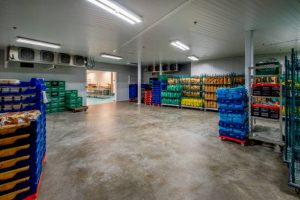Warehouses are around every corner in 2023 serving as the backbone of the global supply chain and playing a crucial role in the storage, distribution, and overall success of countless industries.
From e-commerce giants to small local businesses, warehouses cater to a wide range of demands and requirements, ensuring that products are stored safely and efficiently until they’re ready to be shipped out to their final destinations.
In this article, we’ll explore the various types of warehouses available in the market today, as well as the unique features, advantages, and operations of each that make them essential components of the modern business landscape.
What Is A Warehouse?
A warehouse is a large commercial building used for the storage, handling, and management of goods, materials, and products. It serves as an essential component in the supply chain, acting as a central hub where items are received, stored, and later distributed to various destinations such as retail stores, distribution centres, or customers directly.
Warehouses are designed to optimise space, efficiency, and safety, often featuring high ceilings, storage racks, and advanced technology to manage inventory. They may also include specific areas for various functions, such as receiving, packing, shipping, and quality control. Warehouses can be operated by manufacturers, wholesalers, retailers, or third-party logistics providers (3PLs).
In recent years, warehouses have evolved to incorporate advanced technologies like warehouse management systems (WMS), automated guided vehicles (AGVs), and robotics to streamline operations, reduce human error, and increase productivity.
Find Your Perfect Forklift
Compare Quotes from Local Forklift Dealerships


Enter Requirements


We Find the Best Deal


Receive your Quote
How Do Warehouses Work?
Warehouses are essential components of the supply chain, responsible for the efficient storage, organisation, and distribution of goods. They operate through a series of processes, including receiving, put-away, storage, inventory management, order picking, packing, shipping, returns processing, and quality control.
By leveraging technology, skilled workers, and strategic layouts, warehouses ensure accurate tracking and timely delivery of items, contributing to a seamless flow of products from manufacturers to end consumers.
The Types Of Warehouses And How They Work
In 2023, there are various types of warehouses catering to diverse business needs and playing a crucial role in the global supply chain. These include:
Public Warehouses
 A public warehouse also know as a cooperative warehouse is a storage facilities that is available for rent to businesses and private sector companies on a short-term or long-term basis.
A public warehouse also know as a cooperative warehouse is a storage facilities that is available for rent to businesses and private sector companies on a short-term or long-term basis.
These warehouses are typically owned and operated by third-party logistics (3PL) providers who offer various services, such as storage, inventory management, packing, and shipping. Public warehouses are ideal for businesses that require flexible storage solutions or have fluctuating inventory needs.
Advantages Of Public Warehouses
- Flexibility: Public warehouses allow businesses to rent space on a short-term or long-term basis, accommodating fluctuating quantities of inventory.
- Cost-effective: Renting space in a public warehouse can be more cost-efficient than investing in a private warehouse, especially for small businesses or those with variable storage requirements.
- Scalability: Businesses can easily scale their storage needs up or down as demand changes, without incurring significant costs.
- Access to additional services: Public warehouses often provide value-added services such as inventory management, packing, and shipping, which can help streamline supply chain operations.
- Reduced risk: By using a public warehouse, businesses can minimise the risks associated with owning and maintaining their own storage facility, such as property taxes, insurance, and security.
Disadvantages Of Public Warehouses
- Limited control: Businesses using public warehouses have less control over inventory management, security, and operational processes compared to private warehouses.
- Potential for higher long-term costs: While public warehouses can be cost-effective in the short term, long-term rental costs may exceed the investment in a private warehouse for some businesses.
- Shared resources: While sharing resources can be an advantage, it also means that businesses may have to compete with other clients for access to equipment, staff, and services, which could lead to delays or inefficiencies.
- Less privacy: Using a public warehouse means storing products alongside those of other businesses, which could raise concerns about privacy and confidentiality.
Private Warehouse
A private warehouse is a storage facility owned and operated by the business that uses it for storing its own products. This type of warehouse is built and managed according to the specific requirements of the company, providing full control over inventory management, security, and operational efficiency. Private warehouses are ideal for large enterprises with high-volume and consistent long term storage needs.
Advantages Of Private Warehouses
- Full control: Complete oversight of inventory management, operations, and security measures.
- Customization: Ability to design and manage the warehouse according to specific business needs.
- Long-term cost savings: Potential financial benefits compared to renting space in public or contract warehouses.
- Privacy: The private company has exclusive use of the facility ensures the confidentiality of stored products and information.
Disadvantages Of Private Warehouses
- High initial investment: Significant capital investment for construction, equipment, and setup as well as staffing and inspections.
- Fixed capacity: Limited flexibility in accommodating fluctuating storage needs or business growth.
- Maintenance and management: Ongoing responsibility for facility upkeep, repairs, and personnel management.
- Less scalability: Challenges in quickly adapting to changing market conditions or expanding operations.
Smart Warehouse
 A smart warehouse is a modern warehouse facility that leverages advanced technology, automation, and data-driven insights to optimise inventory and raw material management, operational efficiency, and overall performance.
A smart warehouse is a modern warehouse facility that leverages advanced technology, automation, and data-driven insights to optimise inventory and raw material management, operational efficiency, and overall performance.
Smart warehouses often use a combination of IoT devices, robotics, AI, and machine learning to streamline warehousing processes.
Advantages Of Smart Warehouses
- Increased efficiency: Automation and advanced technology streamline processes, reducing manual labour and boosting productivity.
- Real-time inventory management: IoT sensors and RFID tags enable accurate, real-time tracking of products and inventory levels for better stock management.
- Data-driven insights: Advanced analytics and machine learning algorithms provide valuable insights to optimise operations and performance.
- Enhanced adaptability: Smart warehouses can quickly adjust to changing market conditions and customer demands, improving overall supply chain resilience.
Disadvantages Of Smart Warehouses
- High initial investment: Implementing smart warehouse technology often requires significant upfront costs for equipment, software, and infrastructure.
- Ongoing maintenance: Advanced systems and equipment may need regular maintenance, updates, and repairs, adding to operational expenses.
- Technical expertise: Managing a smart warehouse requires skilled personnel with knowledge of the technology and systems in place.
- Cybersecurity risks: Increased reliance on digital systems and IoT devices can expose warehouses to potential cybersecurity threats, requiring robust security measures that come with additional costs.
Distribution Centres
 Distribution centres are large-scale facilities that serve as central hubs for the storage, handling, and distribution of products within a supply chain. They play a crucial role in managing inventory, customer service, fulfilling customer orders, and ensuring efficient transportation of goods to retailers or end consumers.
Distribution centres are large-scale facilities that serve as central hubs for the storage, handling, and distribution of products within a supply chain. They play a crucial role in managing inventory, customer service, fulfilling customer orders, and ensuring efficient transportation of goods to retailers or end consumers.
Distribution centres often incorporate advanced technology and logistics systems to optimise their operations, and Ecommerce businesses couldn’t function without them.
Advantages Of Distribution Centres
- Centralised inventory management: Distribution centres allow businesses to consolidate inventory in a central location, simplifying stock management and reducing the risk of stockouts or overstocking.
- Faster order fulfilment: By serving as a hub for product storage and shipping, distribution centres enable quicker order processing and more efficient delivery times to customers or retailers, improving customer satisfaction.
- Reduced transportation costs: Centralising distribution operations can lead to economies of scale in transportation, as products are shipped in bulk to the distribution centre and then distributed to their final destinations.
- Optimised supply chain: Distribution centres provide better visibility and control over the entire supply chain, making it easier to monitor performance, identify bottlenecks, and implement improvements.
Disadvantages Of Distribution Centres
- Operational expenses: Running a distribution centre involves ongoing expenses, such as personnel salaries, utilities, maintenance, and insurance, which can impact profit margins.
- Complexity: Managing a distribution centre requires expertise in logistics, inventory management, and technology systems, adding complexity to a company’s operations.
- Geographic limitations: A distribution centre’s location may limit its reach, potentially making it less effective in serving distant markets or customers. This may necessitate the establishment of multiple distribution centres, further increasing costs and complexity.
Distribution Centre vs Warehouse
A distribution centre and a warehouse both serve as storage facilities for products within a supply chain, but they differ in their core functions and operations.
A warehouse primarily focuses on the storage of goods for extended periods, with minimal handling or processing.
In contrast, a distribution centre is designed for efficient product movement, handling, and distribution, with a focus on faster order fulfilment and inventory turnover. Distribution centres incorporate advanced logistics systems and technology to manage inventory, process orders, and coordinate shipments to retailers or end customers.
Bonded warehouse
A bonded warehouse, also known as a customs warehouse or government warehouse, is a secure storage space where imported goods can be stored without immediately paying import duties or taxes. These warehouses are licensed and regulated by the customs authorities of the respective country and are used by importers, exporters, and manufacturers to defer payment of duties until the goods are removed from the warehouse for domestic consumption or re-exported.
Advantages Of Bonded Warehouses
- Deferred customs duties and taxes: One of the primary advantages of bonded warehouses is the ability to defer payment of customs duties and taxes until goods are removed from the warehouse, improving cash flow and reducing the financial burden on businesses.
- Flexible storage periods: Bonded warehouses often allow for extended storage periods, providing businesses with more time to find buyers, arrange transportation, or manage inventory levels according to market demands.
- Enhanced security: Bonded warehouses are licensed and regulated by customs authorities, ensuring a high level of security and safety for stored goods. This reduces the risk of theft, damage, or loss during the storage period.
Disadvantages Of Bonded Warehouses
- Additional costs: Utilising bonded warehouses may involve extra expenses, such as warehouse fees, security charges, and administrative costs, which can impact a business’s profit margins.
- Complex regulations: Bonded warehouses are subject to strict customs regulations and documentation procedures, requiring businesses to invest time and resources in compliance management.
- Limited accessibility: Goods stored in bonded warehouses may face restrictions on access or movement, potentially impacting a business’s ability to respond quickly to market changes or customer demands.
Cold Storage Warehouse
 A cold storage warehouse is a specialised type of climate-controlled warehouse designed to maintain a consistent low temperature to preserve perishable products, such as food products, pharmaceuticals, and certain chemicals.
A cold storage warehouse is a specialised type of climate-controlled warehouse designed to maintain a consistent low temperature to preserve perishable products, such as food products, pharmaceuticals, and certain chemicals.
These warehouses use advanced refrigeration systems and temperature-controlled environments to ensure that products retain their quality, freshness, and safety during storage and transportation.
Advantages Of Cold Storage Warehouses
- Product preservation: Cold storage warehouses maintain consistent low temperatures, ensuring perishable items retain their quality, freshness, and safety during storage and transportation.
- Reduced spoilage: Temperature-controlled environments minimise the risk of product spoilage, reducing waste and financial losses for businesses dealing with perishable goods.
- Regulatory compliance: Cold storage facilities help businesses comply with industry-specific regulations and standards related to the proper handling and storage of temperature-sensitive products.
- Specialised services: Cold storage facilities often provide value-added services tailored to specific industries, such as temperature-controlled transportation, product monitoring, and inventory management, enhancing supply chain efficiency for temperature-sensitive goods.
Disadvantages Of Cold Storage Warehouses
- Higher operational costs: Cold storage warehouses consume more energy due to the advanced refrigeration systems, leading to increased utility costs and potentially impacting profit margins.
- Specialised equipment and maintenance: These facilities require specialised equipment and regular maintenance, which can result in additional expenses for businesses utilising cold storage services.
- Limited flexibility: Cold storage warehouses are designed specifically for temperature-sensitive products, making them less suitable for storing non-perishable goods or items that require different storage conditions.
- Environmental impact: The energy consumption and refrigerant usage associated with cold storage facilities can contribute to greenhouse gas emissions and climate change, raising concerns about their environmental impact.
Hazardous Materials (Hazmat) Warehouses
 Hazmat warehouses are specialised storage facilities designed to offer a safe space to store, handle, and manage hazardous substances and dangerous materials.
Hazmat warehouses are specialised storage facilities designed to offer a safe space to store, handle, and manage hazardous substances and dangerous materials.
These warehouses adhere to strict safety regulations, guidelines, and procedures to minimise the risk of accidents, spills, or exposure to harmful materials.
Advantages Of Hazmat warehouses
- Enhanced safety: Hazmat warehouses implement strict safety measures, protocols, and specialised equipment to minimise risks associated with hazardous materials, ensuring a safer working environment for employees and the surrounding community.
- Regulatory compliance: These facilities adhere to numerous local, national, and international regulations governing hazardous materials storage, helping businesses stay compliant and avoid potential fines or legal issues.
- Expertise in handling hazardous materials: Hazmat warehouses employ trained professionals with expertise in managing dangerous goods, providing businesses with the assurance that their materials are being handled safely and efficiently.
- Reduced liability: By utilising a hazmat warehouse, businesses can minimise potential liability related to accidents, spills, or incidents involving hazardous materials, as these facilities are designed specifically to manage such risks.
Disadvantages Of Hazmat warehouses
- Higher costs: Hazmat warehouses typically involve higher operational and maintenance costs due to specialised equipment, safety measures, and regulatory compliance requirements, which can impact profit margins for businesses.
- Limited flexibility: These facilities are designed specifically for hazardous materials and may not be suitable for storing non-hazardous goods or items requiring different storage conditions, limiting their versatility.
- Complex regulations: Navigating the numerous regulations governing hazmat warehouses can be time-consuming and complex, potentially leading to delays or increased administrative burdens for businesses.
- Location restrictions: Hazmat warehouses may be subject to zoning restrictions or additional permitting requirements, limiting the choice of locations and potentially increasing costs or logistical challenges for businesses.
Which Warehouse Is Best For You?
To determine the best warehouse for your business, consider the following factors:
- Type of products: Analyse the nature of the goods you handle. If your products are perishable or temperature-sensitive, a cold storage warehouse is the best choice. If you deal with hazardous materials, a hazmat warehouse is essential. For general merchandise, a standard warehouse will suffice.
- Storage requirements: Consider the specific storage conditions your types of products require, such as temperature, humidity, and special handling procedures. Choose a warehouse that can accommodate these needs.
- Location: Select a warehouse that is strategically located near your suppliers, customers, or transportation hubs to optimise logistics and reduce transportation costs.
- Size and scalability: Evaluate your current and future storage needs. Choose a warehouse with sufficient space to accommodate your inventory and the flexibility to expand as your business grows.
- Services offered: Look for warehouses that offer value-added services, such as inventory management, order fulfilment, or transportation, to streamline your supply chain and improve efficiency.
- Costs: Compare the costs of various warehouse options, including rent, utilities, maintenance, forklifts and additional services, to find one that fits your budget.
- Security and safety: Ensure the warehouse has robust security measures and safety protocols in place to protect your products and employees.
By carefully assessing these factors, you can choose the warehouse that best aligns with your business needs and helps optimise your supply chain operations.
Final Thoughts
In conclusion, warehouses are indispensable components of the global supply chain, ensuring the efficient storage and distribution of goods across various industries. With the availability of diverse warehouse types, businesses can select the most suitable option based on their specific needs, product types, and operational requirements.
By carefully considering factors such as location, size, scalability, services offered, costs, security, and safety, businesses can optimise their warehousing strategies and ultimately contribute to their overall success. As technology continues to advance, we can expect further innovations in warehousing, providing even more tailored solutions for the ever-evolving demands of modern material handling.